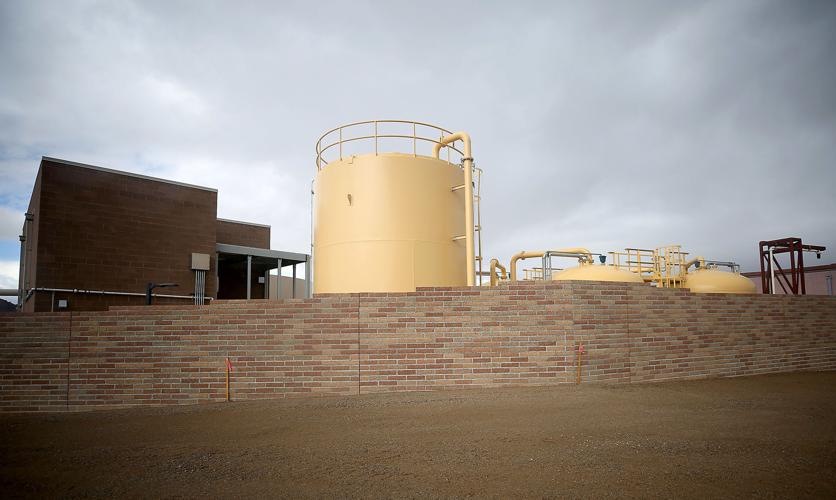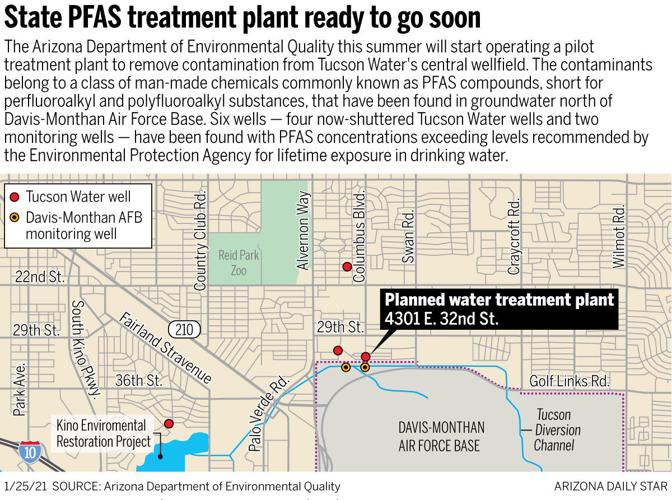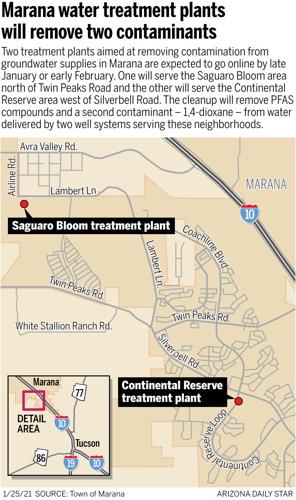Contamination fouling drinking water in parts of Marana and near Davis-Monthan Air Force Base in Tucson is due for separate cleanups soon.
The cleanups will dramatically lower concentrations of what health authorities say are excessive levels of a family of chemicals that have been known to be in the city’s and town’s groundwater supplies since 2016.
Those chemicals, commonly known as PFAS compounds, are considered “forever chemicals” by many pollution experts because they don’t break down easily in water. The Environmental Protection Agency considers several chemicals in the PFAS family to be potentially cancer-causing.
The Marana cleanups will also remove from drinking water 1,4-dioxane. That’s a common, synthetic industrial chemical that the EPA classifies as a known human carcinogen.
While the two cleanups are both attacking PFAS compounds, the efforts will differ widely in cost and scope. While the Marana cleanup marks the end of the town’s efforts to tackle PFAS contamination of its aquifer, the one in Tucson is just the beginning of a cleanup that’s likely to last decades.
The Tucson details
In Tucson, the Arizona Department of Environmental Quality will start constructing in the spring and start operating in the summer a pilot treatment plant to remove PFAS compounds from wells just north of Davis-Monthan. The wells lie in the city’s central wellfield, long Tucson Water’s most important groundwater source.
The construction work is part of a larger effort, costing $3.3 million, that also involves drilling and measuring contaminant levels in monitoring wells in the area, all near D-M. The treatment plant will be located just north of the base, where PFAS compounds were used in firefighting foam from the 1970s until 2017.
In areas north and west of the air base, four city wells and two monitoring wells have been found with PFAS levels exceeding 70 parts per trillion. That’s the maximum level the EPA says people should be exposed to in drinking water over a lifetime.
One monitoring well has shown PFAS levels of more than 14,000 parts per trillion. One city well has had PFAS levels of over 2,900 parts per trillion, an ADEQ report shows.
All these city wells have been taken out of service. The entire central wellfield is currently used for drinking only during peak demand periods in the summertime if it’s used at all, Tucson Water officials say.
That’s because the city today gets most of its drinking water supply from Central Arizona Project water from the Colorado River.
Tucson Water spokesman Fernando Molina said utility officials don’t believe that people have had significant exposure to water from those four wells, at least since the city started switching from groundwater to CAP water in 2001.
But the city wants to get the aquifer cleaned in case that wellfield is needed in the future if and when Colorado River supplies run short. ADEQ says the entire central wellfield potentially could serve up to 600,000 people.
If these chemicals keep migrating downhill from D-M, “several additional drinking water production wells in Tucson Water’s central wellfield will be impacted and removed from service, which will reduce the available water supply for the City of Tucson. The central wellfield … is the sole alternate drinking water supply to the Central Arizona Project for central Tucson,” said an August 2020 ADEQ report on the contamination.
The Marana details
In Marana, two treatment plants that cost a total of $16 million to build will come online in late January or early February to remove contaminants from a half-dozen wells contained in two systems, serving more than one-third of the Marana water utility’s more than 9,100 customers.
One well system serves residents in Saguaro Bloom and surrounding neighborhoods in the Twin Peaks area north of Interstate 10. The other serves residents in the Continental Reserve area west of Silverbell Road, running south from the Twin Peaks area to south of Ina Road.
In both areas, residents have been drinking bottled water and installing water filtration systems in their homes in lieu of consuming contaminated tap water. Once the plants start operating, all residents and other customers will be getting treated water within a couple of days.
But town officials say they expect to be treating water for 20 years before all the aquifer contamination is removed.
Cleanups diverge in scope
Both the Tucson and Marana cleanups are planned to reduce PFAS concentrations to less than 18 parts per trillion. That’s the level Tucson Water has set as a goal for PFAS in other contaminated groundwater supplies elsewhere in its service area, including parts of the city’s south side.
The 18 parts per trillion is what another federal agency — the Agency for Toxic Substances and Disease Control — suggested in a 2018 report is the maximum concentration of the two most commonly found PFAS compounds that people should be exposed to in drinking water over a lifetime.
Also, Marana plans to treat the 1,4-dioxane to the point where it can’t be detected in groundwater, said Scott Schladweiler, the town’s water utility director.
Where the cleanups diverge is in their scope.
Marana’s effort is aimed at removing chemicals from all the wells in the two affected systems.
The ADEQ cleanup for now will be a more limited effort and is seen as a start of a much bigger cleanup that would remove most or all of the PFAS contamination that’s been found at levels deemed excessive.
When the Marana cleanup starts, the two plants will be treating at least 355 million gallons a year, compared to nearly 150 million gallons per year slated for treatment at first by ADEQ’s pilot plant.
ADEQ says it’s still evaluating the extent of the PFAS contamination plume in the area north of Davis-Monthan.
The state has drawn up a detailed “work plan” for this effort that calls for installing a network of up to 16 new groundwater monitoring wells.
It also plans to collect and analyze soil and sediment data from this general area to determine where and how intensively PFAS compounds are contaminating groundwater there.
Because this new plant will be located in an area of high PFAS concentrations, ADEQ expects it will be operated long beyond any pilot treatment phase. It will be used as part of a full-scale remedy that would be installed at a later date, now unknown.
The state agency is actively working toward the goal of designing and constructing the full-scale remedy, its officials said. Typically, groundwater cleanups on this scale “can take many years to complete,” the agency says.
Tucson Water has pegged the full cost of cleaning up this wellfield and separate PFAS contamination of its south-side wellfield at well into the tens of millions of dollars. The ADEQ cleanup won’t affect that south-side area.
As an example, the cleanup of trichloroethylene, 1,4-dioxane and PFAS compounds at a plant on Tucson’s south side is still not finished, about 25 years after its first phase went online, at that time treating only TCE.
But ADEQ officials say that even this more limited pilot cleanup system, because of its location where PFAS contamination is most serious, will immediately start to cut off and prevent continued spread of the highest PFAS concentrations.
“This will result in a less contaminated aquifer and will save significant time and expense for cleanup,” ADEQ said in an email to the Star.
“The security and availability of healthy drinking water for the second-largest metropolitan area in Arizona is critical,” ADEQ said.
Besides the pilot cleanup effort and collecting data on monitoring well and soil contamination, ADEQ said it will spend the rest of the $3.3 million on creating a full-scale cleanup plan for the long term.
A top priority, but much more money needed
Although the U.S. Department of Defense is actively investigating sources of PFAS contamination from federal facilities, Tucson Water requested ADEQ’s assistance to expedite cleanup action, along with the ongoing federal environmental investigation, to prevent additional well impacts in the short-term, ADEQ said.
“ADEQ’s actions related to their Central Tucson PFAS project is fully supported by the city of Tucson,” Tucson Water Interim Director John Kmiec said in a statement. “We have been, and continue to be, ready and willing to support the state in their efforts to investigate and eventually mitigate the area of the aquifer north of Davis-Monthan to protect against any additional movement of PFAS toward the city’s central wellfield.”
Tucson City Councilman Steve Kozachik, who first publicly disclosed the PFAS city well contamination, said he applauds ADEQ’s pilot cleanup efforts and continued study. But he said its $3.3 million “will probably be one-tenth of what it is going to cost us to actually fix this problem.”
When the city’s Washington, D.C., lobbyists, recently asked Kozachik for his top three priorities for 2021, he told them that besides addressing the COVID-19 pandemic, “my number 1, 2 and 3 priorities are PFAS,” he said.
He wants to see the EPA finally establish a formal drinking water limit and a hazardous waste designation for the compounds, which would help bring in federal Superfund toxic waste cleanup money.
His concern is that the PFAS contamination plume will migrate farther north into the central wellfield while studies of the problem continue.
“If it migrates farther into the central wellfield, we’re in deep trouble,” he said.






